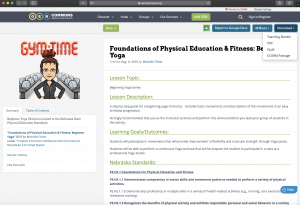Openly licensed educational content is content the public can access under the terms of the license. For example, adding a creative commons license to open educational resources (OER) means an individual can take the content within the OER and use it however they would like, including mix with other OER. However, as per licensing, they must give proper attributions were required. It is my understanding online educational content is that which is shared on the internet, may not always be edited or openly accessed, and comes in many forms across an array of platforms, databases etc.
I found a website, OER Commons, that is a “public digital library of open educational resources.” (OER Commons, 2020) It is a database of resources spanning an array of disciplines that fall under a “Creative Commons Attribution-Non Commercial-ShareAlike 4.0 License” unless otherwise specified. This is exceptional for collaborating with people around the world as you strive to improve your own curriculum/classroom, a feature they highlight. For this assignment I have chosen to review an OER yoga workout. As I employ the evaluation guide, critically analyzing the accuracy and quality, the resource checks the box of most areas. Arguably, the quality in what is being offered is good, it is clear and understandable with no large errors, spelling or otherwise.
I have attached a screenshot below where you can see how the entire lesson is clearly outlined, easily navigated, and offered in multiple alternative formats (PDF, Teaching Bundle etc.).

As noted in the screenshot, you can export this to google docs which I know a lot of people, myself included, appreciate. I would have liked if this OER had video tutorials to match the yoga workout sequence to further the accessibility and demonstrate the poses properly. It is important, especially for the changing bodies of young people, the poses be offered in proper alignment with relevant modifications. I feel this is an area the yoga workout has fallen short, to a detrimental degree. It is missing these fundamental yogic philosophies like ahimsa, meaning non-violence to yourself and all others. I specifically bring this Sanskrit word to our attention as it invites one to practice yoga in such a way each pose is steady and kind to ones individual body. Thus, highlighting how significant variations are.
Moreover, when yoga is taught in this way, focusing on a “yoga workout” it invites a washing over of traditional yogic practices perpetuating the harm caused by the cultural appropriation of yogic practices by white-dominate agencies, programs, and peoples. This is intrinsically linked to the violent colonization of indigenous Hindu yoga practitioners, and a manifestation of the western yoga industrial complex/capitalistic commodification of yoga. Therefore, in addition to my concern about accessibility I would say this OER omits fundamental content. I find myself reflecting and asking myself: just because I have access, legally speaking, does that give me permission to continue to teach it? I would like to learn more about multicultural OER and the implications of implementing and accessing across cultures.
Word Count (not including references): 500
References:
Crosslin, M. (2018). Creating Online Learning Experiences. Retrieved from https://uta.pressbooks.pub/onlinelearning/
OER Africa (2020). Open Educational Resources. Retrieved from https://www.oerafrica.org/book/tutorial-objectives
OER Commons (2020).
Foundations of Physical Education & Fitness: Beginner Yoga.Retrieved from https://www.oercommons.org/authoring/48444-foundations-of-physical-education-fitness-beginner/view
Photo by Daniel Fazio on Unsplash

Leave a Reply